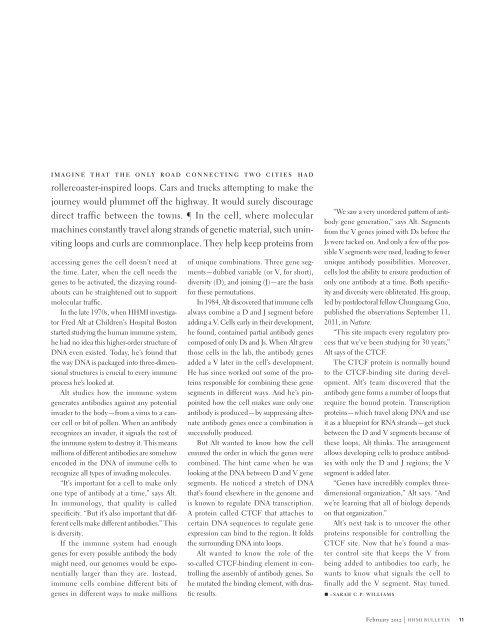Download PDF - Howard Hughes Medical Institute
Download PDF - Howard Hughes Medical Institute
Download PDF - Howard Hughes Medical Institute
You also want an ePaper? Increase the reach of your titles
YUMPU automatically turns print PDFs into web optimized ePapers that Google loves.
IMAGINE THAT THE ONLY ROAD CONNECTING TWO CITIES HAD<br />
rollercoaster-inspired loops. Cars and trucks attempting to make the<br />
journey would plummet off the highway. It would surely discourage<br />
direct traffic between the towns. In the cell, where molecular<br />
machines constantly travel along strands of genetic material, such uninviting<br />
loops and curls are commonplace. They help keep proteins from<br />
accessing genes the cell doesn’t need at<br />
the time. Later, when the cell needs the<br />
genes to be activated, the dizzying roundabouts<br />
can be straightened out to support<br />
molecular traffic.<br />
In the late 1970s, when HHMI investigator<br />
Fred Alt at Children’s Hospital Boston<br />
started studying the human immune system,<br />
he had no idea this higher-order structure of<br />
DNA even existed. Today, he’s found that<br />
the way DNA is packaged into three-dimensional<br />
structures is crucial to every immune<br />
process he’s looked at.<br />
Alt studies how the immune system<br />
generates antibodies against any potential<br />
invader to the body—from a virus to a cancer<br />
cell or bit of pollen. When an antibody<br />
recognizes an invader, it signals the rest of<br />
the immune system to destroy it. This means<br />
millions of different antibodies are somehow<br />
encoded in the DNA of immune cells to<br />
recognize all types of invading molecules.<br />
“It’s important for a cell to make only<br />
one type of antibody at a time,” says Alt.<br />
In immunology, that quality is called<br />
specificity. “But it’s also important that different<br />
cells make different antibodies.” This<br />
is diversity.<br />
If the immune system had enough<br />
genes for every possible antibody the body<br />
might need, our genomes would be exponentially<br />
larger than they are. Instead,<br />
immune cells combine different bits of<br />
genes in different ways to make millions<br />
of unique combinations. Three gene segments—dubbed<br />
variable (or V, for short),<br />
diversity (D), and joining (J)—are the basis<br />
for these permutations.<br />
In 1984, Alt discovered that immune cells<br />
always combine a D and J segment before<br />
adding a V. Cells early in their development,<br />
he found, contained partial antibody genes<br />
composed of only Ds and Js. When Alt grew<br />
those cells in the lab, the antibody genes<br />
added a V later in the cell’s development.<br />
He has since worked out some of the proteins<br />
responsible for combining these gene<br />
segments in different ways. And he’s pinpointed<br />
how the cell makes sure only one<br />
antibody is produced—by suppressing alternate<br />
antibody genes once a combination is<br />
successfully produced.<br />
But Alt wanted to know how the cell<br />
ensured the order in which the genes were<br />
combined. The hint came when he was<br />
looking at the DNA between D and V gene<br />
segments. He noticed a stretch of DNA<br />
that’s found elsewhere in the genome and<br />
is known to regulate DNA transcription.<br />
A protein called CTCF that attaches to<br />
certain DNA sequences to regulate gene<br />
expression can bind to the region. It folds<br />
the surrounding DNA into loops.<br />
Alt wanted to know the role of the<br />
so-called CTCF-binding element in controlling<br />
the assembly of antibody genes. So<br />
he mutated the binding element, with drastic<br />
results.<br />
“We saw a very unordered pattern of antibody<br />
gene generation,” says Alt. Segments<br />
from the V genes joined with Ds before the<br />
Js were tacked on. And only a few of the possible<br />
V segments were used, leading to fewer<br />
unique antibody possibilities. Moreover,<br />
cells lost the ability to ensure production of<br />
only one antibody at a time. Both specificity<br />
and diversity were obliterated. His group,<br />
led by postdoctoral fellow Chunguang Guo,<br />
published the observations September 11,<br />
2011, in Nature.<br />
“This site impacts every regulatory process<br />
that we’ve been studying for 30 years,”<br />
Alt says of the CTCF.<br />
The CTCF protein is normally bound<br />
to the CTCF-binding site during development.<br />
Alt’s team discovered that the<br />
antibody gene forms a number of loops that<br />
require the bound protein. Transcription<br />
proteins—which travel along DNA and use<br />
it as a blueprint for RNA strands—get stuck<br />
between the D and V segments because of<br />
these loops, Alt thinks. The arrangement<br />
allows developing cells to produce antibodies<br />
with only the D and J regions; the V<br />
segment is added later.<br />
“Genes have incredibly complex threedimensional<br />
organization,” Alt says. “And<br />
we’re learning that all of biology depends<br />
on that organization.”<br />
Alt’s next task is to uncover the other<br />
proteins responsible for controlling the<br />
CTCF site. Now that he’s found a master<br />
control site that keeps the V from<br />
being added to antibodies too early, he<br />
wants to know what signals the cell to<br />
finally add the V segment. Stay tuned.<br />
W –SARAH C.P. WILLIAMS<br />
February 2o12 | HHMI BULLETIN<br />
11
















